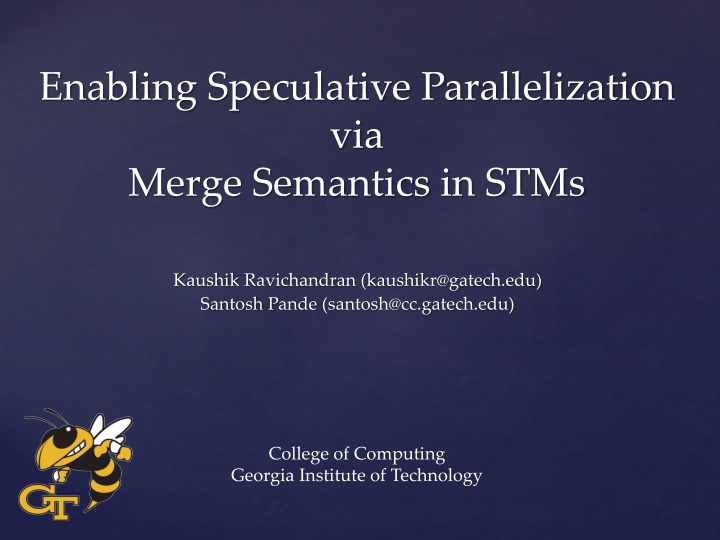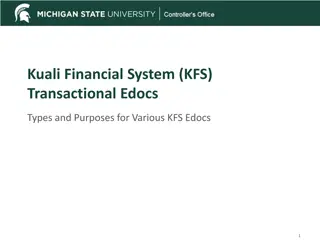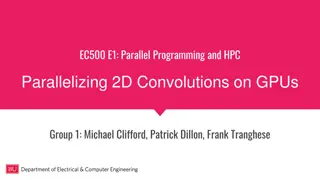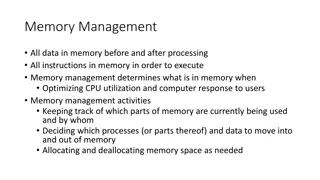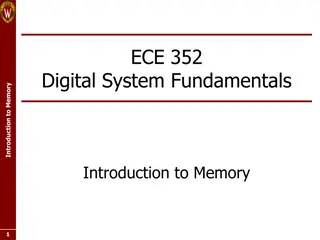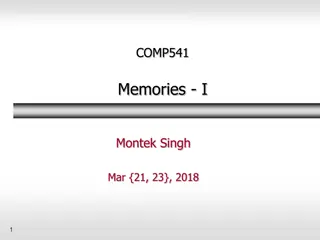Enhancing Parallelization in Software Transactional Memory Systems
Explore how merge semantics in STMs enable speculative parallelization, addressing irregular parallelism challenges. The research covers connected components, parallel applications, and the utilization of speculation for optimized execution in diverse computing scenarios.
Download Presentation

Please find below an Image/Link to download the presentation.
The content on the website is provided AS IS for your information and personal use only. It may not be sold, licensed, or shared on other websites without obtaining consent from the author.If you encounter any issues during the download, it is possible that the publisher has removed the file from their server.
You are allowed to download the files provided on this website for personal or commercial use, subject to the condition that they are used lawfully. All files are the property of their respective owners.
The content on the website is provided AS IS for your information and personal use only. It may not be sold, licensed, or shared on other websites without obtaining consent from the author.
E N D
Presentation Transcript
Enabling Speculative Parallelization via Merge Semantics in STMs Kaushik Ravichandran (kaushikr@gatech.edu) Santosh Pande (santosh@cc.gatech.edu) College of Computing Georgia Institute of Technology
Outline Introduction Connected Components Problem and Speculative Parallelization STMs and the Merge Construct Evaluation Conclusion
Parallelism in Applications Regular Parallel Applications Irregular Parallel Applications HPC Applications Pointer Based Applications Dense Matrix Computations Simulations Graphs, Trees Linked Lists Large Amount of Parallelism Significant Amount of Parallelism available Easily parallelized Difficult to parallelize
Irregular Parallelism Parallelism depends on runtime values Pointer based which makes it difficult to statically parallelize Non-overlapping sections can be processed in parallel Speculation coupled with optimistic execution allows parallelization Examples: applications with disconnected sparse graphs
Outline Introduction Connected Components Problem and Speculative Parallelization STMs and the Merge Construct Evaluation Conclusion
Connected Components Problem (CCP) Applications: Video Processing Image Retrieval Island Discovery in ODE (Open Dynamic Engine) Object Recognition Many more
Connected Components Problem (CCP) 1 1 2 2 1 2 1 2 1 1 2
1 Serial Solution 1 1 1 1 1 Pseudo-code (DFS Strategy) insert node into nodes_stack for each node in nodes_stack: if node is marked continue mark node insert node into marked_nodes for each neighbor of node: insert neighbor into nodes_stack 2 2 2 2 Each iteration of loop depends on previous iteration 2
Speculative Parallelization Serial Thread
Speculative Parallelization 1 1 2 2 1 2 1 2 1 1 2 Parallelized Computation
Speculative Parallelization Wrong Speculation
Speculative Parallelization 2 1 2 1 1 2 Wrong Speculation
Speculative Parallelization Serial Thread Wrapped in STM STMs provide atomic construct and take care of conflicts by rolling back one thread
Speculative Parallelization Serial Thread Wrapped in STM
Speculative Parallelization Serial Thread Wrapped in STM
Speculative Parallelization 1 1 2 2 1 2 1 2 1 1 2 Serial Thread Wrapped in STM Sort of Data Parallelism over an Irregular Data Structure Can we do better?
Outline Introduction Connected Components Problem and Speculative Parallelization STMs and the Merge Construct Evaluation Conclusion
Software Transactional Memory (STMs) STMs optimistically execute code and provide atomicity and isolation Monitor for conflicts at runtime and perform rollbacks on conflicts Can be used for speculative computation but not designed for them Main STM Overheads: Logging Rollback after conflict
Software Transactional Memory (STMs) STMs optimistically execute code and provide atomicity and isolation Monitor for conflicts at runtime and perform rollbacks on conflicts Can be used for speculative computation but not designed for them Main Overheads: Logging Rollback after conflict Inherent cost of rollback Cost of lost work Do we have to discard all the work? Checkpointing state (Safe compiler-driven transaction checkpointing and recovery, OOPSLA 12, Jaswanth Sreeram, Santosh Pande) Can we try merging the state from the aborting transaction?
Merge Construct STMs discard work from transaction Can we salvage the work that it has done? Can try to merge what it has processed with other transaction
Merge Construct STMs discard work from transaction Can we salvage the work that it has done? Can try to merge what it has processed with other transaction 0101101101110001101010 110101101100111
Merge Construct STMs discard work from transaction Can we salvage the work that it has done? Can try to merge what it has processed with other transaction 0101101101110001101010 110101101100111 01010101011100111010101010 Application dependent
Merge for CCP Conceptually Simple t1 t2 nodes_stack marked_nodes nodes_stack marked_nodes A transaction conflicts only because it was working on the same component Before a transaction is discarded take its nodes_stack and marked_nodes list and add it to the continuing transaction Call this MERGE function after a conflict (t1: continuing transaction, t2: aborting transaction)
Merge for CCP We need deal with two main issues: Consistency of Data Structures in T2 (Aborting Transaction) Safety of updates for Data Structures in T1 (Continuing Transaction) We use two user-defined functions MERGE and UPDATE (t1: continuing transaction, t2: aborting transaction)
Data Structures in T2 When can T2 abort? Can abort only when it read/writes to shared state A B When can T2 abort? Can abort only when it read/writes to shared state (A or B) Are it s data structures nodes_stack and marked_nodes safe to use in the merge function?
Data Structures in T2 A B Irrespective of conflict at A or B Both Data structures nodes_stack and marked_nodes either have node or do not have it (t1: continuing transaction, t2: aborting transaction) Valid State of Data Structures
Data Structures in T2 A B Switch around lines 20 and 21 A B
Data Structures in T2 A B If conflict at B marked_nodes has node while nodes_stackdoes not have it neighbors (t1: continuing transaction, t2: aborting transaction) Invalid State of Data Structures
Detecting Invalid or Valid States Step 1: Identify Conflict Points Easy step since STMs typically wrap these instructions in special calls Step 2: Identify Possibility of an Invalid State At each of the points from Step 1 check if the MERGE function has a set of valid data structures as described in previous slides. If valid, then nothing needs to be done If cannot be determined easily or invalid use SNAPSHOT API SNAPSHOT API: Call to API made by programmer at a point in code (typically start/end of loop) Make a copy of the data structures Use only this copy in MERGE function Example coming up
Data Structures in T1 T1 still executing when T2 is aborting (performing MERGE) Provide MERGE specific data structures: merged_nodes_stack and merged_marked_nodes for use in MERGE
Data Structures in T1 Now the information needs to be incorporated back into the main data structures Programmer defines UPDATE function Indicates safe points to invoke UPDATE using SAFE_UPDATE_POINT() call
Outline Introduction Connected Components Problem and Speculative Parallelization STMs and the Merge Construct Evaluation Conclusion
Experimental Evaluation Minimum Spanning Tree (MST) Benchmark Connected Components Benchmark Configuration: Dual quad-core Intel Xeon E5540 (2.53GHz) GCC 4.4.5 with O3 on Ubuntu 10.10 OpenMP used to parallelize the code TinySTM 1.0.0 (ETL)
Minimum Spanning Tree (MST) Pseudo-code while node do: if node is marked return mark node with tree number insert node into marked_nodes find the next edge from the marked_nodes frontier else returns add this edge to tree_edges node = this edge s unmarked node
MST Benchmark Results with 4 different configurations Serial Implementation (No parallelism and No STM overheads) STM based Parallelization STM based Parallelization with Merge STM based Parallelization with Merge and Snapshot Results from 4 different datasets DS1 (6000 nodes): X = 6000, T = 6, N = 6. DS2 (9000 nodes): X = 9000, T = 5, N = 6. DS3 (12000 nodes): X = 12000, T = 4, N = 8. DS4 (16000 nodes): X = 16000, T = 3, N = 8. Randomly generated parameterized graphs
MST Results Parallelization using simple STM based speculation gives performance improvement when compared to the serial implementation Performance using simple STM based speculation drops after 4 threads (due to higher contention) STM Parallelization with Merge outperforms other implementations and scales Snapshot adds slight overhead but still demonstrates good scalability
MST Results Speedup over Serial 12 10 8 Speedup STM Without Merge 6 STM With Merge 4 STM With Merge and Snapshot 2 0 1 2 4 8 Cores STM Parallelization with Merge scales well Snapshot-ing shows overheads but still scales well At 8 threads 90% faster than serial Actually demonstrates super linear speedups
Conclusion Speculation is needed to deal with Irregular Parallelism STMs can be used for speculation but are not designed for it The merge construct provides explicit support for speculation by reducing the overheads of mis-speculation We deal with issues of consistency and safety of data structures during the merge We demonstrate good scalability when compared to regular STM based speculation by reducing overheads of mis-speculation
Thank you! Q & A Looking for applications, suggestions welcome Code shortly available at: http://sourceforge.net/projects/mergestm Contact at: kaushikr@gatech.edu
